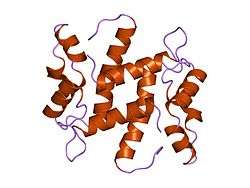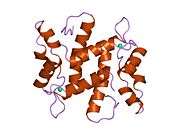mS100a7a15
The S100 calcium-binding protein mS100a7a15 is the murine ortholog of human S100A7 (Psoriasin) and human S100A15 (Koebnerisin). mS100a7a15 is also known as S100a15, mS100a7 and mS100a7a and is encoded by the mS100a7a gene (alias: S100a15)[1][2]
S100 proteins are a diverse calcium-binding family that mediate fundamental cellular and extracellular processes including cell proliferation and differentiation, cell migration, and the antimicrobial host defense as antimicrobial peptides.
mS100a7a15 was first cloned as mS100a15 from adult mouse skin (FVB/N mice, clone RP1-128L15, accession no.: AL591704).[2] Today, the protein is of further interest because of its role in innate immunity, epidermal cell maturation and epithelial tumorigenesis. Additionally, it can serve as surrogate model to study hS100A7 and hS100A15 functions.
Function
Epithelial homeostasis and antimicrobial host defence
Skin: In new-born mouse skin, mS100a7a15 is localized to the epidermal granular and cornified layers of the interfollicular epidermis and to the maturing cells of hair follicles.[2][3] In maturing keratinocytes, mS100a7a15 is induced by calcium mediated differentiation dependent on protein kinase C (PKC).[2] It is upregulated in a TLR4 dependent manner by E.coli stimulation and might have antimicrobial effects against E.coli like its human counterparts.[4] In the dermis, it is expressed by the smooth muscle cells of the panniculus carnosus.[2]
Breast: mS100a7a15 is weakly expressed in normal mammary gland tissue.[3]
Epithelial Carcinogenesis
Breast cancer: mS100a7a15 is upregulated in DMBA induced mammary gland tumors confined to epithelial tumor cells.[3] mS100a7a15 overexpression in mammary epithelial cells enhances proliferation, angiogenesis and metastasis through induction of prometastatic and angiogenic factors like CCL2, Cox-2, MMP2, MMP9 and VEGF. Furthermore mS100a7a15 recruits tumor-associated-macrophages (TAM) through RAGE and Stat3 activation to promote tumorigenesis.[5][6]
Inflammation
mS100a7a15 is upregulated in inflamed skin.[3] TPA (12-O-Tetradecanoylphorbol-13-acetate), a potent PKC activator, induces mS100a7a15 expression. TPA induces mS100a7a15 through AP-1 but not NF-κB.[2] Similar to psoriasin, mS100a7a15 recruits leukocytes and induces proinflammatory chemokines as well as cytokines in keratinocytes through RAGE activation as an alarmin.[5][7] Similar to its human counterparts, mS100a7a15 mediates inflammation through RAGE (like psoriasin) and through an unknown receptor (like koebnerisin).[7] A bi-transgenic mouse model (K5-tTA/TetOmS100a7a15) that expresses abundant mS100a7a15 throughout the basal epidermal layer showed an increased infiltration of CD3+ and CD4+ T lymphocytes into the skin that was associated with an increased production of Th1 and Th17 cytokines and cathelicidin/LL-37.[7]
Special characteristics
Genomic organization and mRNA splice variants
mS100a7a15 is encoded within the murine equivalent of the human EDC on chromosome 3qF1. The mouse transcript is organized in three exons and two introns, spanning an open reading frame of 327 nucleotides.[2]
Protein
The deduced mS100a7a15 protein sequence has two helix-loop-helix motifs corresponding to the for S100 proteins typical conserved C-terminal and a variant N-terminal EF-hand calcium binding sites. The translated mS100a7a15 protein features 109 amino acids, with a calculated molecular weight of 12.87 kDa and a predicted pI of 6.18.[2]
Evolution
The mS100a7a15 gene is encoded in a single genomic region on chromosome 3qF1 that corresponds to the human chromosome 1q21 where psoriasin (S100A7) and koebnerisin (S100A15) are encoded. This indicates that the mS100a7a15 gene is close to the ancestor of the human orthologs.[2][8]
References
- ↑ "Entrez Gene: S100 calcium binding protein A7A".
- 1 2 3 4 5 6 7 8 9 Wolf, R; Voscopoulos, CJ; FitzGerald, PC; Goldsmith, P; Cataisson, C; Gunsior, M; Walz, M; Ruzicka, T; Yuspa, SH (July 2006). "The mouse S100A15 ortholog parallels genomic organization, structure, gene expression, and protein-processing pattern of the human S100A7/A15 subfamily during epidermal maturation". The Journal of Investigative Dermatology. 126 (7): 1600–8. PMID 16528363. doi:10.1038/sj.jid.5700210.
- 1 2 3 4 Webb, M; Emberley, ED; Lizardo, M; Alowami, S; Qing, G; Alfia'ar, A; Snell-Curtis, LJ; Niu, Y; Civetta, A; Myal, Y; Shiu, R; Murphy, LC; Watson, PH (17 February 2005). "Expression analysis of the mouse S100A7/psoriasin gene in skin inflammation and mammary tumorigenesis". BMC Cancer. 5: 17. PMC 553966
 . PMID 15717926. doi:10.1186/1471-2407-5-17.
. PMID 15717926. doi:10.1186/1471-2407-5-17. - ↑ Büchau, AS; Hassan, M; Kukova, G; Lewerenz, V; Kellermann, S; Würthner, JU; Wolf, R; Walz, M; Gallo, RL; Ruzicka, T (November 2007). "S100A15, an antimicrobial protein of the skin: regulation by E. coli through Toll-like receptor 4". The Journal of Investigative Dermatology. 127 (11): 2596–604. PMID 17625598. doi:10.1038/sj.jid.5700946.
- 1 2 Nasser, MW; Qamri, Z; Deol, YS; Ravi, J; Powell, CA; Trikha, P; Schwendener, RA; Bai, XF; Shilo, K; Zou, X; Leone, G; Wolf, R; Yuspa, SH; Ganju, RK (1 February 2012). "S100A7 enhances mammary tumorigenesis through upregulation of inflammatory pathways". Cancer Research. 72 (3): 604–15. PMC 3271140
 . PMID 22158945. doi:10.1158/0008-5472.CAN-11-0669.
. PMID 22158945. doi:10.1158/0008-5472.CAN-11-0669. - ↑ Shubbar, E; Vegfors, J; Carlström, M; Petersson, S; Enerbäck, C (July 2012). "Psoriasin (S100A7) increases the expression of ROS and VEGF and acts through RAGE to promote endothelial cell proliferation". Breast cancer research and treatment. 134 (1): 71–80. PMID 22189627. doi:10.1007/s10549-011-1920-5.
- 1 2 3 Wolf, R; Mascia, F; Dharamsi, A; Howard, OM; Cataisson, C; Bliskovski, V; Winston, J; Feigenbaum, L; Lichti, U; Ruzicka, T; Chavakis, T; Yuspa, SH (8 December 2010). "Gene from a psoriasis susceptibility locus primes the skin for inflammation". Science Translational Medicine. 2 (61): 61ra90. PMID 21148126. doi:10.1126/scitranslmed.3001108.
- ↑ Kulski, JK; Lim, CP; Dunn, DS; Bellgard, M (April 2003). "Genomic and phylogenetic analysis of the S100A7 (Psoriasin) gene duplications within the region of the S100 gene cluster on human chromosome 1q21". Journal of Molecular Evolution. 56 (4): 397–406. PMID 12664160. doi:10.1007/s00239-002-2410-5.


